
Catalog excerpts

Electronic Platemeter Model EC09 User Manual
Open the catalog to page 1
CONDITIONS OF SALE AND GUARANTEE Congratulations on the purchase of your Jenquip EC09 Folding plate pasture meter. This meter is a high precision engineered device for measuring the average height of pasture relative to density of the pasture. This is directly relative to the quantity of dry matter present (Kilograms of dry matter.) Learning to operate your Jenquip Folding Plate Pasture Meter won’t take long. You will soon find it to be an invaluable tool in your farming operation for day-to-day feeding decisions and long term feed budgeting. Please retain this instruction book for future...
Open the catalog to page 2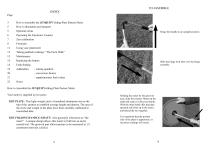
Page 3 How to assemble the JENQUIP Folding Plate Pasture Meter 5 How to dismantle and transport 5 Optional extras 6 Operating the Electronic Counter 11 Using your platemeter 12 Taking paddock readings: “The Farm Walk” 13 Maintenance 19 Addendum - cutting quadrats 21 - supplementary feed values How to Assemble the JENQUIP Folding Plate Pasture Meter Your meter is supplied in two parts : THE PLATE: This light-weight circle of anodised aluminium sits on the top of the pasture to establish average height and density. The area of the circle and weight of the plate have been...
Open the catalog to page 3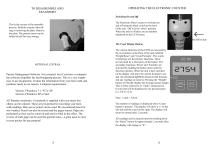
OPERATING THE ELECTRONIC COUNTER This is the reverse of the assembly process. Hold the counter when fitting or removing the plate. Remove the plate. The pasture meter can be folded in half for easy storage. Switching On and Off The Electronic Plate Counter is switched on and off using the black switch at the back of the unit. Off is in the ‘down’ position. When the unit is off there are no numbers displayed on the LCD screen. OPTIONAL EXTRAS Pasture Management Software. Not essential, but if you have a computer the software simplifies the feed budgeting process. This is a very simple easy...
Open the catalog to page 4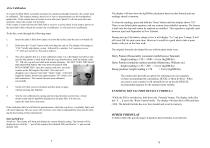
Zero Calibration To ensure the Plate Meter accurately measures the compressed height of pasture, the counter must be calibrated. This requires setting a base level of zero so measurements can be benchmarked against this. If the counter does not return to zero after each "plonk" it will not record the measurement - hence the counter will not beep. If the counter is removed from the black tube or receives a severe knock it may jump a groove on the steel shaft which will put the counter out of calibration. It will need to be recalibrated. To do this, work through the following steps: 1. Insure...
Open the catalog to page 5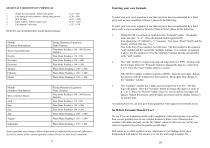
SEASONAL VARIATIONS OF FORMULAS Entering your own formula. xl25 + 640 xl30+990 x165+1480 x159+1180 x157+ 970 Months (Northern Hemisphere) Months (Southern Hemisphere) 1 Winter & early spring - before stem grown 2 Late spring & early summer - during stem growth 4 Early autumn - before autumn rain 5 Late autumn - after rain DEXCEL also developed these month based formulas: To enter your own cover equation or one that may have been recommended by a third party such as your consultant or Dexcel please do the following: To enter your own cover equation or one that may have been...
Open the catalog to page 6
have heard of disagreements with grazing contracts based around meter readings where each party thinks a different formula should be used. The answer is unbiased—for the most accurate formula, cut, dry and weigh a sample (See “Cutting Quadrats” in the Addendum). This weight is then compared with a meter reading for the same sample, using the various formulas, to see which one most closely matches the weight of the sample. Remember—be Consistent with your farm walk and formulas and you will end up with records which are meaningful, comparable and very useable. Using Your Plate Meter...
Open the catalog to page 7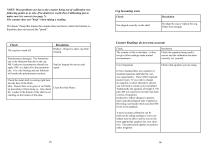
NOTE: Most problems are due to the counter being out of calibration (see following points as to why. If in doubt it is worth Zero Calibrating just to make sure it is correct (see page 7). The counter does not "beep" when taking a reading If it doesn’t beep this means the counter does not know where the bottom is -therefore does not record the "plonk"
Open the catalog to page 9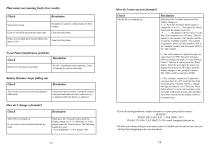
Plate meter not running freely (low results) Front Panel (membrane) problems Battery Retainer keeps falling out If you are having problems, require assistance or spare parts please contact : JENQUIP REID LINE EAST, R.D. 5, FEILDING 4775 Ph (06) 323 6146 : FAX (06)323 6116 email Jenquip@clear.net.nz We trust your meter will give you many years of valuable service and we are sure you will find feed budgeting to be very beneficial.
Open the catalog to page 10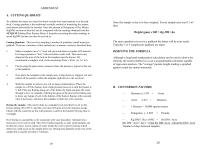
A. CUTTING QUADRATS To calibrate the meter you must first know exactly how much pasture is in the paddock. Cutting quadrats is the traditional scientific method of measuring dry matter, used almost universally for decades. Once the amount of Kilograms of Dry Matter (KgDM) are known then this can be compared with the readings obtained from the JENQUIP Folding Plate Pasture Meter. A formula converting the meter readings to actual KgDM/ hectare can then be arrived at. Cutting Quadrats: This involves sampling a number of quadrates (small areas) per paddock. There are variations of this method...
Open the catalog to page 11
1 cubic metre of silage averages 800 kg (0.8 tonne). To estimate DM content of silage, twist the silage in your hand to see how easily the juice is expressed. — If juice easily expressed by hand, DM below 18% — If juice expressed with difficulty, 18-22% — If little or no juice expressed but hands moist, 22-27% Silage - Hay conversions — 1 tonne direct cut silage = 9 bales hay Hay Conventional bale of hay weighs 20-25 kg. A 25 kg bale has the approximate equivalent feeding value of: — Two 14 kg bales of barley straw — 120 kg direct cut silage — 70 kg wilted silage...
Open the catalog to page 12All Jenquip catalogs and technical brochures
-
Jenquip
29 Pages




